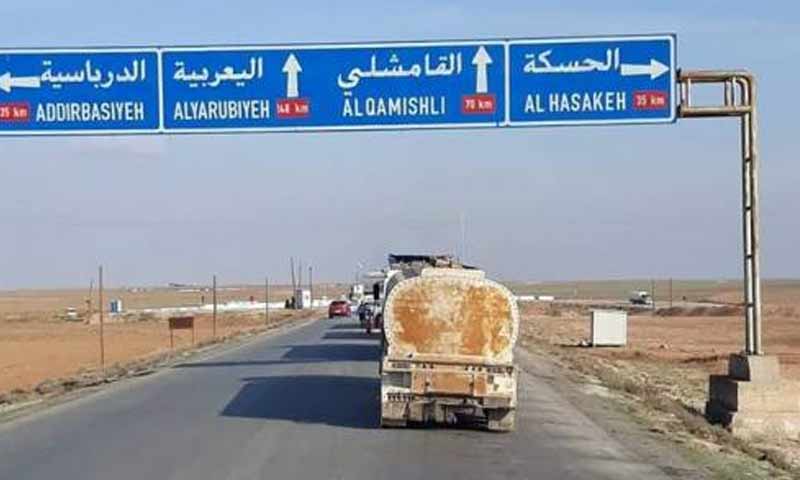



It has been a month since northeast Syria’s Kurdish-led Autonomous Administration stopped sending petroleum tank trucks to the Syrian regime-held areas, despite the de-escalation of tensions between the two sides.
Enab Baladi has learned from a worker (who spoke on the condition of anonymity for security reasons) in the oil fields of Rmelan, controlled by the US-backed Syrian Democratic Forces (SDF), that the administration has suspended the sale and supply of oil products to the Syrian regime since 29 January. The areas under the control of the Syrian government used to obtain about 130 oil tanks from the Rmelan oil field and 50 tanks from the field of al-Shaddadi on a daily basis.
The unnamed worker said that the SDF, the military arm of the Autonomous Administration, made a decision— which has not been officially announced yet—to stop the fuel supplies to the Syrian regime. He believes that the decision likely came at the request of the United States of America or the Kurdish-led SDF to exert pressure on the Syrian regime following recent tensions in Qamishli at the beginning of January.
The worker did not exclude the possibility that the SDF would sell oil products to the Syrian regime again, but only under “a new agreement and higher prices.”
The correspondent of Enab Baladi in Raqqa confirmed that no fuel tanker trucks have passed recently through the Umm Madfaa-Abu Khashab route–this route is usually taken by tanker trucks in order to transport oil products from the SDF-linked areas to the regime’s.
On 2 February, the Internal Security Forces of the Autonomous Administration, commonly known as the Asayish in the Jazira, Euphrates, and Afrin Regions, have ended the siege on the Syrian regime-held areas. These include the cities of al-Hasakeh and Qamishli, with Russian mediation. The siege lasted for 20 days. The blockade was imposed as a result of mutual arrests and shootings. Besides, according to vice president of the administration, Badran Jia Kurd’s comments to the online Kurdish Hawar news agency, “the Syrian regime refused to recognize the existence of the Autonomous Administration.”
For nearly nine years, the SDF has controlled the most important oil fields in northeastern Syria with the US forces’ support. These include the Rmelan and al-Shaddadi oil fields in al-Hasakeh governorate and the al-Omar and al-Tanak oil fields in Deir Ezzor governorate.
The SDF sells petroleum products to several parties: the Syrian regime, the opposition-controlled areas in the countryside of Aleppo, and the local market. Moreover, some fuel products are being smuggled into northern Iraq.
On 22 February, the fuel tank trucks began to return from Athria square in the countryside of Aleppo to the governorate of Homs. They waited for more than 15 days in the SDF’s areas of control to be filled up with the oil for transport to the Homs refinery.
An earlier batch of oil tankers remained “stuck” east of the Euphrates and did not load their cargo. Therefore, truck drivers went back to their homes.
A fuel tank truck driver, requesting that his name be withheld, told Enab Baladi that more than 300 tank trucks were waiting in the Athria square before the drivers began to leave. He confirmed that about 150 trucks are still in the SDF areas waiting to be re-filled.
The Qatirji Company, which manages the transportation of oil, did not guarantee compensation for the drivers who left after a long and tiring wait. The company considered those drivers who left the square responsible for their actions; thus, they bear the losses entirely.
The driver added that he waited 20 days in the square. He was forced to return with a group of his co-workers after they “ran out of supplies.” He did not know when he had to go back to work. In return, the company refused to provide them with compensation or companions in order to facilitate their return to their homes. (Companions help them pass the checkpoints spread along the travel road.)
He pointed out that he and his co-workers have sustained significant material losses, represented in the travel costs and large sums of money paid at checkpoints. At the same time, they were afraid to leave their trucks in the square for fear of theft.
The Syrian regime depends on the fuel tank trucks to transport fuel products from the SDF oil fields to the Homs refinery. The regime has faced challenges in solving the constant fuel crisis that people in its areas of control experience.
According to a statement to the People’s Assembly on 3 February by the Minister of Oil in the Syrian government, engineer Bassam Tohme, 60 percent of the population have not received their allocations from heating oil yet, “due to the conditions imposed by the siege and the coercive economic measures imposed on the Syrian people, and the shortages of oil products.”
if you think the article contain wrong information or you have additional details Send Correction